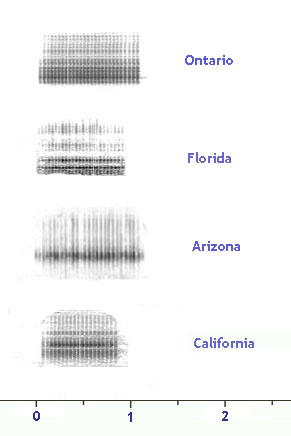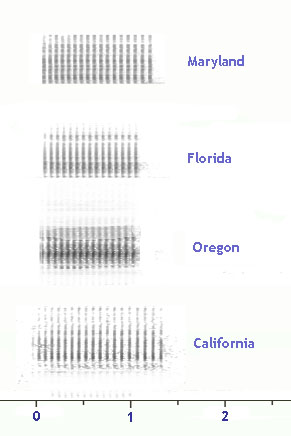Instead of song, most woodpeckers use a mechanical drumming sound as their audio advertising display. It’s easy to tell when you hear a woodpecker, harder to tell which species. Nevertheless there are distinct differences between species, and with practice most drumming sounds can be recognized with a high level of confidence.
I’m comparing just Downy and Hairy woodpeckers here, but these happen to be two of the most easily distinguished drums, and the differences are clearly evident in the sonagrams shown below, as well as in the linked audio recordings. ((Pitch of woodpecker drumming depends mostly on the thing being drummed – a hollow log, rotten branch, or metal gutter all make very different sounds – so I’ve cropped these sonagram snippets to match each other, and left off the y-axis scale of pitch.))
I was particularly interested to check for geographic variation in drumming sounds of these two species. With evidence that other forest birds like Brown Creeper and White-breasted Nuthatch have diverged significantly in three or four regions, and a similar result in a recent DNA study of Hairy Woodpecker, it is plausible that Hairy and Downy Woodpecker could be hiding some cryptic species. As you can see from the sonagrams above, however, there is little or no regional variation in their drums. The species-specific differences described above apply across the entire North American continent.
Jackson and Ouellet (2002) summarize several studies on variation in Downy Woodpecker drumming. Both males and females drum, and no consistent sexual, seasonal, or regional difference in drumming has been found.
One potential regional variation involves the length of the drum. The two California samples each diverge from the normal duration for the species: Hairy Woodpecker shorter than elsewhere, Downy Woodpecker longer. This is a sample size of one, and given that much more extensive studies (see preceding paragraph) could not find any regional difference this almost certainly is not meaningful. Observers in California and nearby should listen to see if the drum of local Downy Woodpeckers is consistently longer than the drum of Hairy, that could offer an extra clue to distinguish the two species there.
References
Jackson, Jerome A. and Henri R. Ouellet. 2002. Downy Woodpecker (Picoides pubescens), The Birds of North America Online (A. Poole, Ed.). Ithaca: Cornell Lab of Ornithology; Retrieved from the Birds of North America Online: http://bna.birds.cornell.edu/bna/species/613
Recordings are available at Cornell’s Macauley Library and at Xeno-canto.




still will need far greater sample sizes to be meaningful… from males and females, juveniles and adults, from different types of wood/trees, even different heights, as well as more regional areas, and perhaps during different seasons of year.
Hi Cyberthrush, The difference between the two species is well-established. I’ve been listening to Downy and Hairy Woodpeckers carefully for a couple of decades and these differences are consistent and reliable. The possible difference in California birds mentioned in my post is pure speculation, and I doubt it will hold up to scrutiny, but as of right now I think it deserves a little scrutiny.
I’ve just updated the post with info from BNA. Specifically “Jackson and Ouellet (2002) summarize several studies on variation in Downy Woodpecker drumming. Both males and females drum, and no consistent sexual, seasonal, or regional difference in drumming has been found.”
Certainly there are occasional immatures or odd birds that drum in an unusual pattern, but that’s to be expected and is no more frequent than, say, unusual singing by Cardinals.
My confusion David, I misread your post to be postulating the possibility of regional differences, when in fact you were deeming it very unlikely; my point was simply that it would require a significant sample size to show a genuine and consistent difference between regions (as you say, the sample size of one is meaningless).
Hello,
I will deviate from the previous topic and consult the following: I am puzzled by a question I was asked about drumming and its nature. Is drumming innate (genetically determined), or is it learned such as some oscines will learn songs?
Thanks in advance, and will appreciate any feedback.
Carolina
Pingback: Is That A Woodpecker Drumming? |
Pingback: Where are sapsuckers now? – Connecticut Bird Atlas
Pingback: New Research Shakes Up Lengthy-held Perception on Woodpecker Hammering - Specialpets
Pingback: New Examine Shakes Up Lengthy-held Perception on Woodpecker Hammering - Animal Everyday
Pingback: New Examine Shakes Up Lengthy-held Perception on Woodpecker Hammering - PetsBlogLive
Pingback: New Research Study Shocks Long-held Idea on Woodpecker Working - Birds2nest